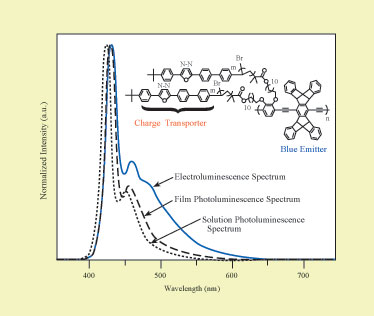
Blue Electroluminescence from a Single Polymer Layer
Anne L. Fischer
Interest in organic LEDs is largely due to their potential for cost-effective device fabrication. Research conducted at Massachusetts Institute of Technology in Cambridge is helping to streamline the process by demonstrating stable blue electroluminescence from a single-layer device.
According to Vladimir Bulovi«c, a member of the group from the Institute for Soldier Nanotechnologies and the Laboratory of Organic Optics and Electronics, a challenge for the development of polymeric and molecular LEDs lies in developing the means to generate spectrally pure blue luminescence with reasonable efficiency and sufficiently long operating lifetime. To do so, the new emitters incorporate poly(phenylene-ethynylene) (PPE), an often disregarded polymeric material, and use energy transfer from small molecule grafts to a PPE backbone.

The chemical structure of one of the poly(phenylene-ethynylene) (PPE) material systems containing a rigid pentiptycene scaffold is shown. The oxadiazole grafts are labeled “charge transporter,” and the conjugated PPE backbone is labeled “blue emitter.” The electroluminescence spectrum of the single-layer organic LED and the photoluminescence spectra of the film and solution are plotted.
In the investigations leading to the development of the devices, the scientists explored five PPE systems. Three featured dialkoxy side-chains, and two contained a rigid pentiptycene scaffold. By using oxadiazole units as the graft material, the researchers combined a charge-transporting segment with a light-emitting conjugated backbone in a single layer. The incorporated pentiptycene scaffold within the PPE structure prevents ground- and excited-state interactions between the pendant oxadiazole units and the conjugated backbone. As a result, the devices exhibit saturated blue luminescence that closely matches the solid-state photoluminescence spectra of the material in solution and of the film after spin-casting.
The new emitters display operating efficiencies of 0.34 cd/A — significantly better than previous PPE-based devices — which Buloic attributes to the perfected chemical design of the polymers. Previous blue devices, for example, had efficiencies of 0.02 cd/A, and their output was not as color-saturated, as a result of PPE aggregation.
The researchers are pleased with the material’s ability to maintain excellent color purity while harnessing the charge-conduction properties of the grafts, but the current single-layer organic LED structure does not demonstrate its full potential. The single-layer devices do not optimize the balance of electron and hole injection into the LED, and they do not position the exciton recombination region in the peak of the optical field of the emitter’s microcavity. Both contribute to lower external electroluminescence quantum efficiencies than would be expected from the photoluminescence quantum efficiencies of the PPE films.
Nano Letters, online June 25, 2005, doi:10.1021/nl050995p.
Published: September 2005